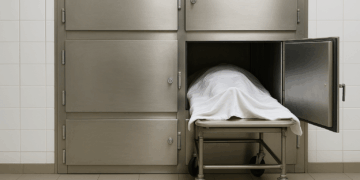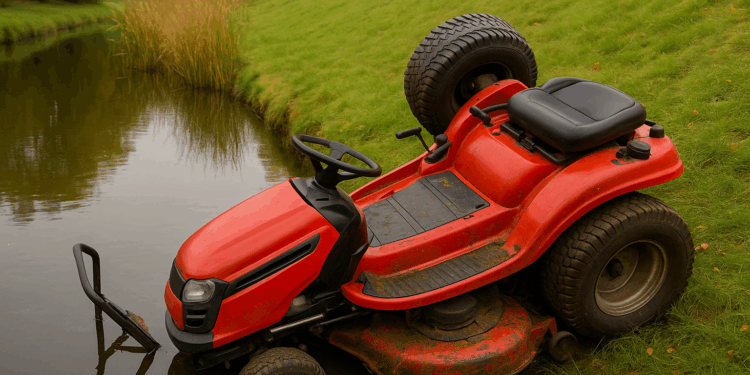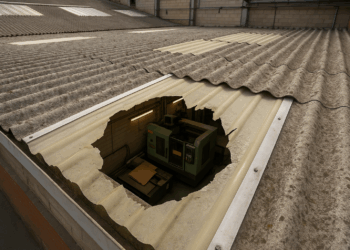Story Highlight
– Kamil Grygieniec, 23, died from lawnmower head injuries.
– Incident occurred on his last day of work.
– He was found submerged in a pond under the mower.
– Inquest revealed mower lacked rollover protection system.
– Witness noted mowing area appeared “risky and steep.”
Full Story
A tragic incident involving a groundworker has drawn attention to safety protocols in the landscaping industry following his fatal accident in North Stainley. Kamil Grygieniec, aged 23, from Northallerton, lost his life on what was to be his final day of employment when the sit-on lawnmower he operated overturned, resulting in severe head injuries.
The inquest into his death took place in Thirsk, where a jury heard the grim details surrounding the accident that occurred on 8 October 2021. Mr Grygieniec had been engaged in grass cutting on a sloped bank on Watermill Lane when he was discovered face down in a pond, trapped beneath the lawnmower. Emergency services pronounced him dead at the scene shortly after they arrived.
Senior coroner Jon Heath guided the jury through their deliberations, stressing that they must ascertain whether Mr Grygieniec’s death was avoidable. His mother, Ava Grygieniec, attended the proceedings, poignantly reflecting on her son’s character and the significant loss felt by his family and friends. She described him as “hard-working and popular,” noting that he was expected to start a new job the following Monday.
“He was an easy-going, popular boy who had a very bright future ahead of him,” she detailed, adding that his friends felt as though they had lost a brother. Originally from Poland, the family had moved to the UK to seek better healthcare for Kamil, who had faced health issues as a child. Ava remarked on their close bond and how well Kamil had adapted to his role, which combined his love for the outdoors with his strong work ethic.
During the inquest, evidence was presented detailing the circumstances of Mr Grygieniec’s death, including findings from a post-mortem examination. The medical report identified “sharp blunt force injuries” to the left side of his head, attributed to the impact of the lawnmower during the incident. The investigation revealed that drowning was not a factor in his death, nor was there any indication that substances such as alcohol or medication played a role.
Witness testimony provided further insights into the conditions at the scene. Local resident Glyn Horner noted that he had observed a gardener working in the area earlier that day. He expressed concern over the steepness of the bank where the mowing was taking place, stating that it appeared “risky and steep,” although he did not see Mr Grygieniec drive erratically.
The Health and Safety Executive (HSE) was also involved in investigating the accident. Expert Francis Ellis examined the lawnmower and found it lacked a rollover protection system, which would have been pivotal in preventing such accidents. She indicated that Mr Grygieniec was not using a seatbelt at the time, leaving him vulnerable during the rollover. Ellis explained the mechanics involved, noting that as the machine rolled over, the effect of gravity would have exerted considerable force on him.
Colleagues of Mr Grygieniec provided further context on the working conditions at MHS Countryside Management. John Holroyd, a former coworker, indicated that he had not received any formal training regarding the safe operation of the mower and had not seen any instructional materials. In contrast, another colleague, Jordan Dickinson, shared that workers were encouraged to voice concerns related to safety. He mentioned that there was a supportive management structure in place which allowed employees to refuse unsafe tasks.
The inquest continues, with the jury’s responsibility to evaluate all the evidence presented, making findings on the circumstances surrounding the accident and whether proper safety measures were adhered to in Mr Grygieniec’s case. As the proceedings unfold, discussions surrounding health and safety regulations within the landscaping industry remain relevant, highlighting the need for stringent adherence to best practices to prevent similar tragedies in the future.
Local authorities and the HSE may face scrutiny over the enforcement of safety measures, and the incident underlines the importance of adequate training and protective systems in preventing workplace accidents. The community in North Stainley has been left mourning the loss of a young man whose life ended tragically, while his family seeks answers about the circumstances leading to his untimely death.
As the authorities review their safety protocols, the wider implications of such incidents serve as a reminder of the ongoing need for vigilance in ensuring the health and safety of workers in all sectors. The inquest’s findings could lead to recommendations for changes in regulations that might enhance workplace safety standards significantly, potentially safeguarding future workers from similar incidents.
































This is heartbreaking. Equipment without proper rollover protection should not be used on steep banks. Employers must ensure machinery is suitable for the task, provide thorough training, and carry out clear risk assessments so workers are not put in harm’s way. Lessons must be learned to prevent another family going through this.
This is devastating. A working environment must have effective risk assessments, suitable equipment and adequate training before anyone is sent to work on steep banks. Machines used where there is a risk of overturning need appropriate protection and employers must ensure tasks are planned so hazards are removed or the risk is reduced as far as reasonably practicable. Lessons from this inquest should lead to clear action on equipment standards, supervision and training so no other family has to suffer like this.
This is a heartbreaking reminder that basic safety measures must never be overlooked. Employers need to assess risks and provide machinery with appropriate equipment and clear instructions for working on slopes. Proper training, supervision and emergency procedures are essential, and industry standards should be reviewed so that no worker faces such preventable dangers.
This is heartbreaking. It highlights the need for proper risk assessment, correct equipment for the terrain and mandatory rollover protection on ride on mowers used on banks, plus clear training and supervision. Employers must ensure machines are fit for purpose and that workers are not exposed to foreseeable hazards. Robust enforcement and industry guidance are needed so no family has to endure a loss like this again.